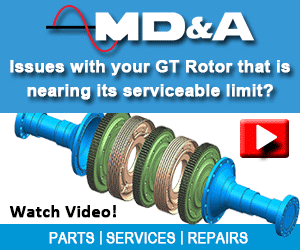It was only a few years ago that owner/operators of GE E- and F-class gas turbines learned technicians from Advanced Turbine Support LLC could extract or blend shims in the first three compressor stages in-situ—no case removal necessary. That was a big deal because shims found protruding into the compressor air stream during a borescope inspection could be dealt with immediately, preventing an offending shim from possibly going downstream and damaging rotating and stator blades.
Update: A week ago, Mike Hoogsteden, Advanced Turbine Support’s director of field services, called to say the company’s technicians had removed in-situ a protruding shim in the 12th stage of a 7EA, saving the owner the more than $400k it would have cost to extract the shim had case removal been required.
It was perfect timing for this industry-first accomplishment given the 7EA Users Group meeting convenes online about two weeks (October 20). Register now (users only) at no cost and come up to speed on developments and experiences in the 7B-EA fleet since the 2019 conference. The virtual venue under the Power Users umbrella is certain to push attendance to new heights and share information valuable in decision-making.

Hoogsteden added that the protruding shim was located above the right case break (photos) and that the peaking unit had recorded about 8500 service hours and nearly 700 starts when the inspection was conducted. He suggested that O&M personnel new to the GE E-class fleet become familiar with TIL-1562, “E- and F-Class Shim Migration and Loss,” issued in January 2007. To dig deeper into the subject, consult the 7EA Users Group library on the Power Users website and meeting reports available in CCJ’s searchable archives at www.ccj-online.com.
Advanced Turbine Support developed, patented, tested, and proved a few years ago the tooling that today allows—depending on rotor stacking—in-situ blending of compressor blades and stator vanes as far back as Stage 12 with favorable access.
The blends can be analyzed by engineering to determine any associated risks both before and after the work is done. Hoogsteden says his company recommends attempting in-situ blends on rotating blades and stationary vanes when engineering analysis confirms such repairs are preferable over immediate unit disassembly.
Concerning shim migration, he adds that once a shim has migrated to approximately 50% of its height and is protruding into the air stream, the OEM no longer considers this a low-to-medium risk condition and it should be removed or blended flush.





